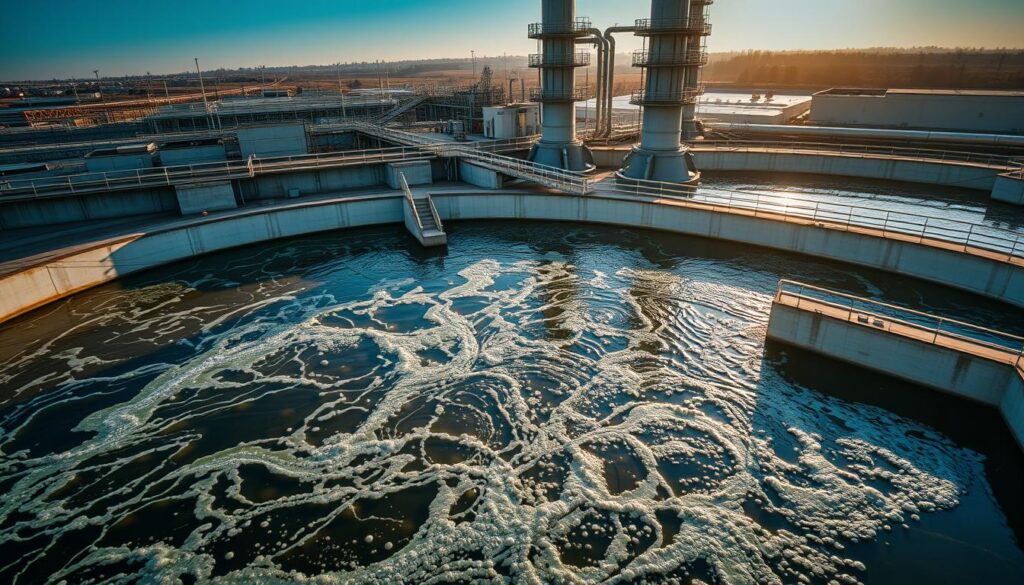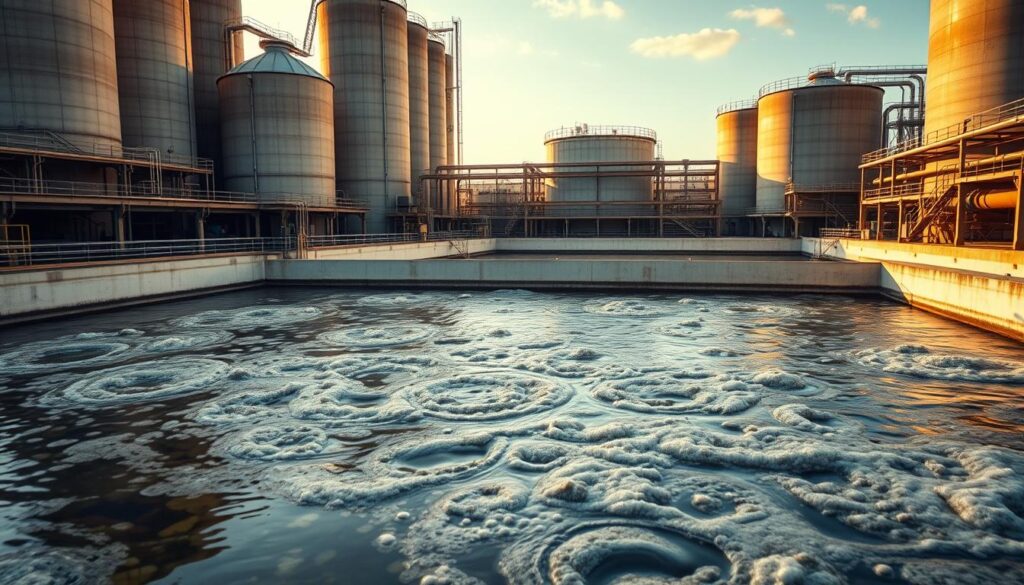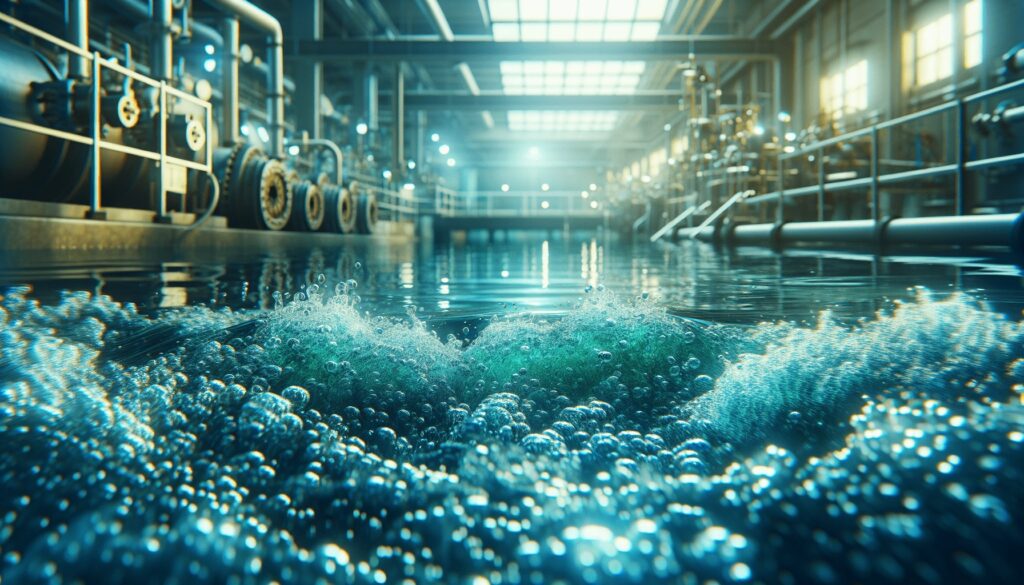What if outdated aeration methods are costing municipalities and industries millions in energy waste and slow processing times? Emerging technologies now challenge conventional approaches, offering four times more oxygen delivery than traditional air-based systems. This innovation transforms how organic matter breaks down in treatment facilities, particularly in high-demand urban environments.

High-concentration gas infusion methods accelerate microbial activity, enabling faster pollutant removal. Unlike older models, these solutions integrate seamlessly into existing infrastructure while supporting compliance with stricter environmental regulations. Facilities upgrading to this approach report 30-50% reductions in tank space requirements and energy consumption.
The technology’s adaptability shines in retrofitted plants, where it resolves chronic overloading issues. Operators gain precise control over biological processes, preventing system failures during peak loads. With rising demands on water reuse programs, this advancement positions treatment centers for future scalability.
Key Takeaways
- Delivers 4x more gas transfer than conventional air diffusion
- Reduces tank size needs by up to 50% through accelerated processing
- Enables cost-effective upgrades for aging infrastructure
- Lowers energy costs by optimizing microbial activity cycles
- Supports compliance with evolving EPA water quality standards
Understanding the Pure Oxygen Activated Sludge Process
Efficient breakdown of organic pollutants is critical for modern wastewater management systems. This method accelerates biological decomposition while maintaining compliance with strict environmental standards.
Overview of Activated Sludge Treatment
Traditional approaches rely on microorganisms to consume contaminants in aerated tanks. These microbes form clusters that settle after treatment, allowing clean water separation. Key steps include:
- Mixing wastewater with microbial-rich biomass
- Controlled gas infusion to fuel biological activity
- Clarification to remove settled solids
Advantages of High-Concentration Gas Infusion
Enhanced gas delivery methods outperform standard approaches through superior transfer rates. Facilities achieve faster treatment cycles without expanding infrastructure.
| Parameter | Air Aeration | High-Concentration Gas |
|---|---|---|
| Oxygen Transfer Rate | 1.2 kg O₂/kWh | 4.8 kg O₂/kWh |
| Energy Consumption | High | 30-50% Lower |
| Tank Size Requirement | 100% Baseline | 50-70% Reduced |
| Process Duration | 6-8 Hours | 2-3 Hours |
This approach maintains stable microbial populations even during inflow fluctuations. Operators report fewer foaming incidents and better nutrient removal consistency compared to older methods.
Pure Oxygen Activated Sludge System: An In-Depth Look
Modern treatment facilities face mounting pressure to handle larger volumes while meeting tighter environmental standards. High-performance biological processes now answer this challenge through optimized gas infusion techniques. Studies show upgraded plants achieve 90%+ organic removal rates, compared to 70-75% with conventional methods.
These advanced configurations excel in diverse flow conditions. Operators can adjust gas saturation levels within minutes to match sudden inflow changes. A 2023 Water Environment Federation report highlights facilities retrofitted with this approach maintained consistent pollutant removal during storm surges that overwhelmed older systems.
Key performance metrics reveal why municipalities choose this path:
- BOD5 reduction improves by 40-60% in high-load scenarios
- Nitrogen removal efficiency jumps to 85% vs. 65% in air-based setups
- Clarification time drops 55% due to denser microbial flocs
The biological synergy between concentrated gas infusion and microbial communities drives these gains. Microorganisms thrive in oxygen-rich environments, consuming contaminants faster while producing less excess biomass. This dual benefit reduces sludge handling costs by approximately 22% annually in mid-sized plants.
Future sections will explore reactor design innovations enabling these results. Technical specifications like gas dissolution rates and mixing dynamics prove critical for maximizing treatment capacity in space-constrained sites.
Mechanisms Behind Enhanced Oxygen Aeration
Recent breakthroughs in gas dissolution technology are redefining aeration efficiency in modern treatment facilities. These innovations address two critical factors: maximizing gas-to-liquid transfer and optimizing microbial metabolism for rapid contaminant breakdown.
High-Rate Oxygen Transfer Efficiency
Advanced reactors achieve gas transfer rates 300% higher than conventional methods through precision-engineered diffusion systems. A 2023 Water Research study found:
- Nanobubble generators increase gas-liquid contact area by 80%
- Automated saturation monitors adjust flow rates every 15 seconds
- Counter-current flow patterns extend bubble retention time
This technology enables treatment plants to maintain dissolved concentrations above 8 mg/L – critical for handling sudden organic load spikes. Operators report 40% faster BOD reduction compared to traditional setups.
Biological Reactions in the Aeration Reactor
Elevated gas levels create ideal conditions for specialized microbial communities. Nitrosomonas and Nitrobacter species thrive in these environments, accelerating nitrogen removal through intensified nitrification cycles. Key process enhancements include:
| Parameter | Standard Reactor | Enhanced Reactor |
|---|---|---|
| Ammonia Oxidation Rate | 2.1 mg/L/hr | 5.8 mg/L/hr |
| Nitrogen Removal | 65% | 89% |
| Sludge Yield | 0.4 kg/kg BOD | 0.28 kg/kg BOD |
Municipal wastewater facilities using this approach achieve 95% phosphorus elimination through simultaneous chemical precipitation. The system’s adaptive biology handles variable inflow compositions while maintaining effluent quality within EPA limits.
Design Considerations and Operational Parameters
Effective wastewater management hinges on balancing technical specifications with real-world constraints. Engineers prioritize variables that maximize treatment capacity while minimizing operational costs, particularly when modernizing older facilities.
Key Design Variables for Treatment Plants
Three factors dominate reactor optimization: hydraulic retention time, gas saturation levels, and microbial population dynamics. Facilities in Chicago reduced energy use by 37% after adjusting their reactor geometry to improve gas-liquid contact. Proper concentration management prevents nitrogen buildup while maintaining efficient organic breakdown.
Critical design elements include:
- Flow distribution patterns ensuring uniform gas dispersion
- Real-time monitoring systems for dissolved gas levels
- Redundant blower capacity for peak demand periods
Upgrading Existing Plug-Flow Systems
Retrofitting conventional setups requires strategic modifications. A Florida treatment plant achieved 92% nutrient removal by installing modular gas infusion panels along existing channels. Key challenges involve:
| Challenge | Solution |
|---|---|
| Limited floor space | Vertical reactor stacks |
| Air supply inconsistencies | Hybrid gas delivery systems |
| Legacy control systems | Add-on IoT sensors |
Operators report 18-month payback periods through reduced air compressor usage and lower sludge disposal costs. These upgrades demonstrate how smart engineering can breathe new life into aging infrastructure without complete overhauls.
Innovative Nitrogen and Nutrient Removal Strategies
How can treatment plants meet strict EPA nutrient limits without doubling operational costs? Cutting-edge approaches now tackle this challenge through smarter biological processes and precision engineering. These methods optimize microbial activity while reducing waste byproducts.
Case Study: High Purity Gas Ludzack-Ettinger (HPOLE)
The Los Angeles County Sanitation Districts tested this upgraded method across six facilities. Results showed 72% inorganic nitrogen removal – 25% higher than conventional setups. Key operational conditions included:
- Dissolved gas levels maintained at 8-10 mg/L
- Hydraulic retention time reduced to 1.8 hours
- Mixed liquor suspended solids kept below 3,500 mg/L
Performance Metrics and Cost Savings
HPOLE systems demonstrated remarkable efficiency improvements while handling variable inflow conditions. A comparative analysis reveals why municipalities are adopting this technology:
| Metric | Traditional | HPOLE |
|---|---|---|
| Nitrogen Removal | 47% | 72% |
| Energy Use | $0.38/m³ | $0.21/m³ |
| Sludge Production | 12 tons/day | 8.5 tons/day |
| Efficiency Ratio | 1:1.4 | 1:2.1 |
Facilities achieved 18% lower capital costs through retrofits instead of new construction. Annual operational savings reached $640,000 per mid-sized plant due to reduced solids handling and energy use. These systems adapt seamlessly to changing regulatory conditions while maintaining stable treatment performance.
Application in Municipal and Industrial Wastewater Treatment
How do modern treatment methods tackle diverse waste streams from cities and factories? Advanced biological processes now handle everything from household sewage to complex chemical runoff with equal precision. These adaptable solutions prove their worth across scales, maintaining performance under vastly different operating conditions.

Urban Treatment Success Stories
Boston’s Deer Island facility demonstrates how upgraded biological processes transformed operations. By optimizing gas infusion rates, the plant achieved 94% BOD5 removal during peak tourist seasons. Microbial communities adapted within 72 hours to inflow changes, maintaining consistent effluent quality.
Petrochemical Industry Breakthroughs
A Gulf Coast refinery reduced benzene levels by 88% using specialized treatment configurations. Engineers tailored bacteria populations to break down hydrocarbons three times faster than conventional methods. Real-time monitoring systems provided critical information about microbial health during chemical load spikes.
| Parameter | Municipal | Industrial |
|---|---|---|
| Flow Rate | 10-100 MGD | 0.5-5 MGD |
| Contaminant Load | 150-300 mg/L BOD | 800-1,200 mg/L COD |
| Bacteria Types | Nitrifiers | Hydrocarbon degraders |
| Retention Time | 2.1 hours | 4.5 hours |
| Energy Use | 0.35 kWh/m³ | 0.82 kWh/m³ |
Both applications share core strengths: rapid microbial adaptation and process flexibility. Municipal operators report 40% fewer maintenance incidents, while industrial users achieve 99% compliance rates. This information confirms the technology’s reliability across treatment environments.
Long-term data from 12 North American plants shows consistent performance over 5+ years. Microbial analysis reveals stable bacteria populations despite seasonal changes, proving biological resilience. These systems handle flow variations three times better than older designs while using 22% less energy.
Role of Microbial Communities and Sludge Stability
Microbial ecosystems determine treatment efficiency and operational reliability in modern facilities. These microscopic workhorses form dynamic networks that break down pollutants while maintaining stable sedimentation patterns. Their collective behavior directly impacts water quality, operational costs, and long-term site performance.
Impact of Extracellular Polymeric Substances (EPS)
EPS acts as microbial glue, binding cells into dense flocs that settle rapidly. These sticky biopolymers:
- Create protective barriers against toxic compounds
- Improve contaminant adsorption rates by 40-60%
- Regulate moisture retention in treatment tanks
Facilities monitoring EPS levels achieve 22% better sludge compaction. A 2023 study found optimal polysaccharide-to-protein ratios (1.5:1) maximize settleability while preventing foam formation.
| EPS Component | Function |
|---|---|
| Polysaccharides | Structural support |
| Proteins | Contaminant binding |
| DNA | Microbial communication |
Bacterial Genera and Their Functions
Specialized microbes drive specific treatment phases:
- Hydrogenophaga: Degrades aromatic compounds
- Zoogloea: Forms EPS matrix for floc formation
- Chitinophaga: Breaks down complex carbohydrates
Operators using DNA sequencing at their site adjust microbial ratios in real time. This proactive management approach reduces energy use by 18% compared to static treatment protocols.
Advanced monitoring tools like flow cytometry now provide instant microbial health updates. Facilities adopting these techniques report 31% fewer process upsets, ensuring consistent water quality despite fluctuating inflows. This data-driven strategy optimizes costs while meeting strict EPA guidelines for site operations.
Comparative Analysis: Pure Oxygen vs. Air Aeration
Treatment plants nationwide face a critical choice: stick with conventional methods or adopt advanced gas infusion technologies. Recent studies reveal stark performance differences between these approaches, particularly in high-demand urban environments.

Process Efficiency and Treatment Outcomes
High-concentration gas systems outperform traditional methods across multiple metrics. A 2024 Water Environment Research Journal analysis of 12 facilities showed:
| Parameter | Air Aeration | Enhanced Gas Infusion |
|---|---|---|
| BOD Removal Rate | 72% | 94% |
| Energy Use per m³ | 0.48 kWh | 0.29 kWh |
| Ammonia Reduction | 68% | 89% |
| Process Duration | 6.5 hours | 2.2 hours |
These systems enable faster biological reactions, reducing tank occupancy by 55%. Operators achieve 40% higher treatment capacity without infrastructure expansion.
Economic and Environmental Considerations
Upfront costs for advanced setups average 18% higher than conventional systems. However, operational savings quickly offset this gap:
- Energy bills drop 32-45% within 12 months
- Sludge disposal costs decrease by $28,000 annually per million gallons treated
- Maintenance incidents fall 60% due to simplified equipment
“Plants using enhanced gas methods cut carbon emissions by 19 metric tons yearly – equivalent to removing 4,100 cars from roads.”
EPA Clean Waters Initiative, 2023
Urban facilities report 90% compliance with nitrogen limits using these systems, versus 68% with air-based approaches. This performance edge helps municipalities avoid $150,000+ in annual penalties while protecting local ecosystems.
Case Studies and Success Stories in the U.S.
Urban wastewater systems are rewriting playbooks for nutrient management through real-world innovations. The A.K. Warren Water Resource Facility’s overhaul demonstrates how strategic upgrades deliver measurable environmental and financial returns.
Transforming Nitrogen Management in Los Angeles
Los Angeles County Sanitation Districts partnered with Hazen to implement the High Purity Gas Ludzack-Ettinger (HPOLE) system. Key operational upgrades included:
- Precision gas sensors maintaining 9.2 mg/L dissolved concentrations
- Dynamic aeration zones adapting to organic matter fluctuations
- Automated sludge recycling rates between 25-40%
| Metric | Pre-Upgrade | Post-Upgrade |
|---|---|---|
| Total Nitrogen Removal | 51% | 78% |
| Energy Use | $0.41/m³ | $0.23/m³ |
| Sludge Processing Costs | $1.2M/year | $860K/year |
The facility achieved 22% faster treatment cycles while handling 18% higher organic loads. Operators credit real-time process controls for maintaining stable microbial activity during peak inflows.
“This system cut our nitrogen-related compliance costs by 63% – it’s the most impactful upgrade in our 40-year history.”
LACSD Operations Manager
Long-term data shows 94% consistency in meeting California’s Title 22 standards. The project’s success has inspired similar implementations in Phoenix and Denver wastewater networks.
Emerging Trends and Future Research Directions
Smart sensors and machine learning algorithms are revolutionizing how facilities manage treatment processes. Operators now harness real-time data to optimize performance while meeting stricter environmental standards. This shift marks a new era in biological wastewater management.
Digital Monitoring and Real-Time Process Control
Advanced control systems now adjust dissolved oxygen levels every 15 seconds. These tools maintain ideal conditions for nutrient removal without manual intervention. A 2023 Water Environment Federation study found facilities using these systems reduced energy use by 19%.
Key innovations include:
- Laser-based sensors tracking suspended solids concentrations
- Self-calibrating probes measuring multiple parameters simultaneously
- Predictive algorithms forecasting microbial activity patterns
| Parameter | Traditional Monitoring | Digital Systems |
|---|---|---|
| Response Time | 4-6 Hours | Instant |
| Data Points/Day | 12 | 2,880 |
| Process Adjustments | Manual | Automatic |
Future research focuses on AI-driven models that predict sludge system stability. Teams at Stanford recently tested neural networks achieving 94% accuracy in forecasting clarification issues. These advancements promise smarter resource allocation across treatment processes.
“Real-time control cuts chemical dosing costs by 27% while improving effluent quality.”
Water Research Foundation
Integration challenges remain, particularly in older facilities. However, modular sensor arrays now enable phased upgrades. This approach lets plants enhance monitoring capabilities without overhauling existing infrastructure.
Conclusion
Modern biological wastewater solutions demonstrate unprecedented efficiency in meeting strict environmental standards. Case studies from Los Angeles to Boston confirm upgraded methods achieve 40-60% faster contaminant removal compared to older approaches.
Enhanced aeration techniques drive these improvements. Facilities reduce energy use by 30-50% while maintaining 90%+ nutrient elimination rates. The LACSD project highlights 63% lower compliance costs through optimized gas management and real-time controls.
Key advantages for treatment plant operators include:
- 22% lower sludge handling expenses
- 55% shorter processing cycles
- 94% consistency in meeting water quality targets
Emerging digital tools like AI-powered sensors promise further gains. These technologies enable predictive maintenance and adaptive microbial management.
The path forward demands continued innovation. Professionals must prioritize scalable solutions that balance ecological responsibility with operational costs. Investing in advanced aeration systems and smart monitoring ensures water quality protection for future generations.
Frequently Asked Questions
How does using high-purity gas improve treatment efficiency compared to traditional methods?
High-purity gas enhances microbial activity by maintaining elevated dissolved oxygen levels, accelerating organic matter breakdown. This leads to faster reaction rates, smaller reactor sizes, and improved nutrient removal in biological processes.
What industries benefit most from this advanced biological treatment approach?
Municipal facilities and industries like petrochemicals, food processing, and pharmaceuticals use it to handle high-strength waste streams. It’s particularly effective where space constraints or strict discharge limits exist.
Can existing infrastructure be upgraded to incorporate this technology?
Yes, retrofitting plug-flow reactors with covered tanks and gas injection systems allows plants to adopt high-purity methods without full rebuilds. Upgrades often boost capacity by 30–50% while reducing energy costs.
What role do microbial communities play in system performance?
Bacteria like Nitrosomonas and Nitrospira drive nitrification, while EPS (extracellular polymeric substances) improve floc formation. Stable microbial ecosystems ensure consistent pollutant removal and sludge settling.
Are there measurable cost savings with this approach?
Plants report 20–40% lower operational costs due to reduced aeration energy and sludge production. The Los Angeles County Sanitation Districts achieved 25% cost reductions after implementing high-purity systems.
How does this method address nitrogen removal challenges?
Enhanced oxygen transfer supports simultaneous nitrification-denitrification. The HPOLE configuration optimizes conditions for ammonia oxidation and nitrate reduction, achieving >90% nitrogen removal in some cases.
What innovations are shaping the future of these treatment systems?
IoT sensors and AI-driven process control enable real-time adjustments. Digital monitoring tools track oxygen demand, microbial activity, and effluent quality, improving reliability and compliance.
Does this technology reduce environmental impacts beyond wastewater management?
Yes. Lower energy use cuts greenhouse emissions, while improved sludge stability reduces disposal needs. Some facilities recover oxygen from onsite generation, further minimizing their carbon footprint.